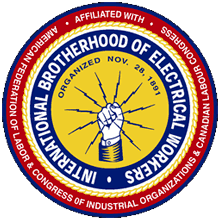July 29, 2014
By Joe Maniscalco
New York, NY – The New York City District Council of Carpenters [NYCDCC] represents thousands of highly trained, middle-class craftspeople who put up buildings better than anyone else. Mayor Bill de Blasio has a plan to build or preserve 200,000 units of affordable housing over the next decade and an electoral mandate to combat growing economic income inequality. So, why is the NYCDCC and other Building Trades still haggling with the mayor over new job opportunities?
"I think the progressive mayor is in kind of a conundrum right now," says Steve McInnis, president, NYCDCC. "They have a serious issue when it comes to workforce development."
In stark contrast to the many non-union outfits now lining up to lowball the city on affordable housing construction, the NYCDCC and other Building Trades offer workers unsurpassed training and a real shot at economic stability.
"I don't think that it's a zero sum game where the only way to get affordable housing is to exploit workers," McInnis says.
The de Blasio administration insists that the Building Trades are an essential part of its affordable housing plan, and that ongoing discussions to increase organized labor's participation in the program have been "very positive and productive."
Just how positive and productive those talks ultimately turn out to be, however, remains to be seen.
The framework of the de Blasio's affordable housing plan still appears to be in flux – with only some variations to the Bloomberg administration's old 80/20 split between market rate and affordable housing developments, being discussed.
According to McInnis, organized labor's economic model already fits in with the construction of higher-end developments. The challenge now, is to find creative ways that will allow the NYCDCC and other Building Trades to compete for the lower-end market as well.
"I think we have to try to work on the economics," McInnis says. "Non-profit groups have shown that there are ways for us to get there. And there has been a willingness from the Carpenters to try and go after that market. But the idea that affordable housing is monolithic, is a little bit of a lazy perception."
The NYCDCC president maintains that the progressive mayor should also consider the Carpenters' true record on workforce diversity when proceeding with his affordable housing plan.
"Show me a woman working on a non-union site today, and I'd be extremely surprised," McInnis says. "I challenge the financiers or the developers out there to compare what our EOC [Economic Equality Compliance] numbers are, with what their EOC numbers are. We've been a social justice organization for 130 years – I think that sometimes gets lost in the discussion."
The Carpenters, as well as the other Building Trades, participate in diversity-building programs including Nontraditional Employment for Women [NEW], Construction Skills 2000 and Helmets to Hardhats – all of which could be further utilized with governmental support.
Working with the Mayor's Office, McInnis insists that organized labor can, indeed, increase diversity even further, while also pulling greater numbers of workers into the middle-class.
"The carpenters union can't solve poverty [on its own], we have to have work opportunities," McInnis says. "We expand membership based on the amount of work hours that we have. [The de Blasio administration] has work – and we have a framework on how to get people to the middle class. I think that we need to be part of that process."



